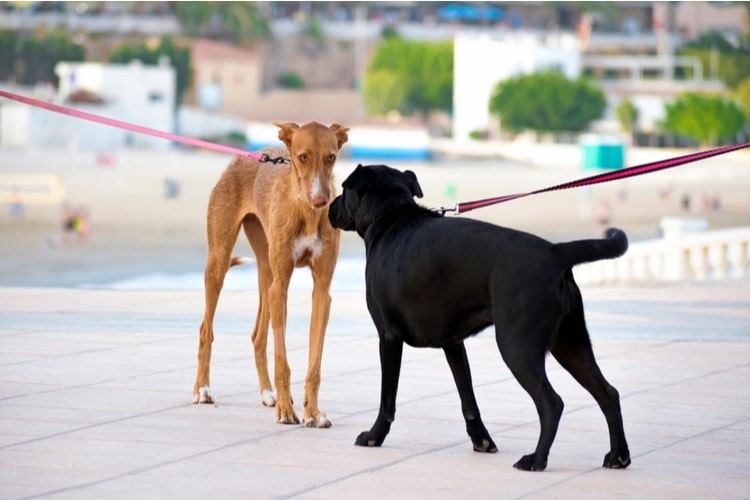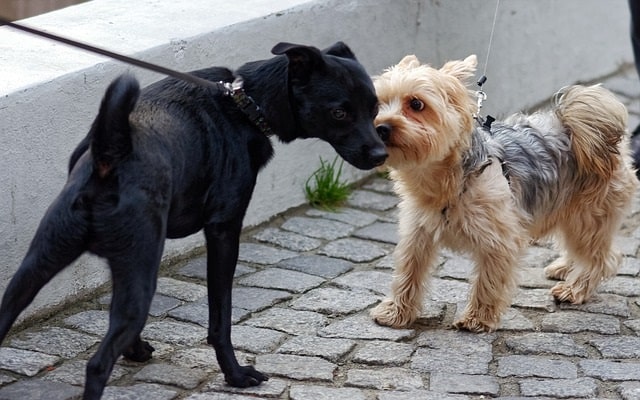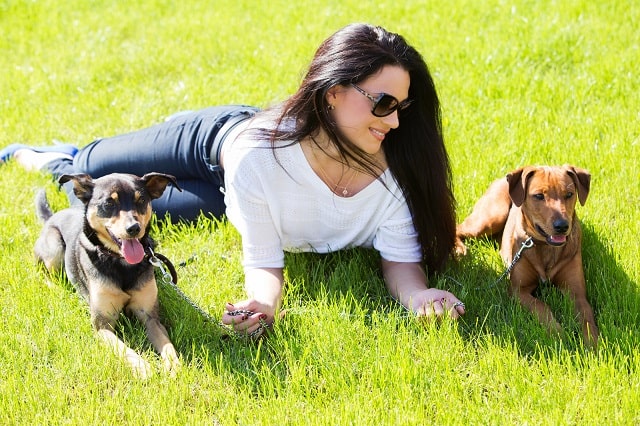Have you been wondering how to introduce dogs to avoid a problem? It’s a common question dog owners ask, such as when they need to introduce a visiting dog to their dog or introduce a nervous dog to other dogs. As a veterinarian, I often get asked tips and tricks to safely introduce two dogs. Introducing dogs can be extremely tricky and can lead to serious injuries if not done correctly. If you follow the steps to introduce dogs outlined in this article, you will have the best chances of successfully introducing two dogs without problems.
1. Go Slowly
When introducing dogs, you should always go slowly. It may take time for your dog to warm up to another dog, especially if they are nervous. If at any point it seems as if either dog is becoming aggressive or very scared, stop the introduction process and try again later. It may take several short on-leash introductions before your dog feels comfortable with another dog. If your dog is aggressive or extremely fearful, you may want to seek help from your veterinarian or a certified dog trainer.
2. Ask For Help
It will take two adults to safely and properly introduce two dogs. Also, don’t be afraid to reach out to a certified dog trainer, veterinarian, or veterinary behaviorist if you are having trouble introducing your dog to other dogs. Especially if your dog is aggressive, you should seek professional help to introduce your dog to other dogs to avoid the risk of harm to the dogs or the people involved in the introduction.
3. Meet on Neutral Ground
The best place to introduce your dog to another dog is on neutral ground.1
Your dog may become fearful, protective, or aggressive if you introduce the new dog inside your house.2 Allow both dogs to meet outside your home or a park. It is best to choose a place where there are not many other dogs or people so your dog doesn’t get overwhelmed or distracted.
4. A Barrier Can Be Helpful
It may help to start the introduction with a chain-link fence or slatted wooden fence in between the dogs. This will give the dogs an added barrier in case they start showing signs of aggression or fear. The openings in the fence will allow them to smell one another and interact without fear of them getting into a fight. This added layer of protection is vital for successfully introducing dogs.
5. Keep Both Dogs on a Leash With an Escape Proof Harness
When you introduce two dogs, this should always be done with both dogs on a leash. This will allow you to be in control of the introduction. It can also be helpful to use a no escape dog harness to decrease the risk of one dog slipping out of their harness. The harness and leash can help you quickly end the introduction if necessary.
6. Take the Dogs for a Walk Together
If the two dogs seem to be getting along during the initial introduction on-leash at a neutral area with a barrier in between, you may be able to take them for a walk together. Find an area where you will be able to walk the dogs together with some distance between the two dogs. A walk can be extremely helpful because it allows the dogs the opportunity to become a bit more acquainted with each other while still being on-leash.
7. Read Body Language
As you go through this process, be very aware of both dogs’ body language and closely monitor the interaction. A happy dog will wag their tail and look comfortable and relaxed. If your dog’s hair is standing up or if they are growling, staring, or baring their teeth, this may be a sign that your dog is not comfortable with the introduction.3 If your dog exhibits any signs of fear or aggression, stop the introduction immediately and try again later or seek professional help.
8. Try a Short Off-Leash Interaction
If at this point, neither dog has shown any signs of fear or aggression and both dogs seem happy with one another, you might consider trying an off-leash interaction after your successful initial on-leash introduction. Keep the session short and closely monitor both dogs so you can quickly separate them if an issue arises.
9. If All Goes Well, You Can Try an In-House Introduction
For dogs that seem to get along well outdoors, you may be able to now introduce the two dogs inside. Hide any toys, food, bones, or treats so there will be no items to fight over. I also recommend placing a baby gate between the two dogs when you first introduce them together inside to make sure the dogs will still be comfortable interacting with each other inside. If both dogs seem comfortable, you can then try removing the baby gate and closely supervising the dogs.
What Should You Not Do When Introducing a Dog?
When introducing a dog, you should not immediately allow the dogs to interact off-leash. This gives you no control over the situation and will not allow you to easily stop the introduction if things aren’t going well. You should also not try to introduce two dogs by yourself. You will need someone else to help you with the introduction process.
Finally, you should never try to force an aggressive or fearful dog to meet another dog.4 If your dog is aggressive or fearful, it is best to avoid introductions with other dogs unless under the guidance of your veterinarian, veterinary behaviorist, or certified dog trainer.
Article Sources
Pet News Daily uses only high-quality sources, including peer-reviewed studies, to support the facts within our articles. Read our editorial process to learn more about how we fact-check and keep our content accurate, reliable, and trustworthy.
- The Ohio State University College of Veterinary Medicine, Indoor Pet Initiative. Introducing a New Dog to Your Current Dog. Indoorpet.osu.edu. Accessed March 28, 2021.
- Horwitz D, Landsberg G. Dog Behavior Problems – Aggression – Unfamiliar Dogs – Diagnosis. Vcahospitals.com. Accessed March 28, 2021.
- The Humane Society of the United States. Introducing your new dog to your other dogs. Humanesociety.org. Accessed March 28, 2021.
- Aztec Animal Clinic. Fear vs. Aggression. Aztecanimalclinic.com. Accessed March 28, 2021.



